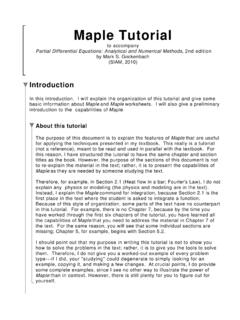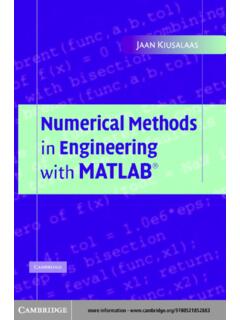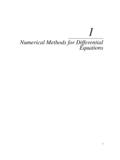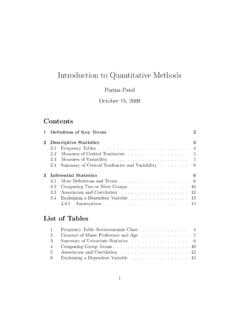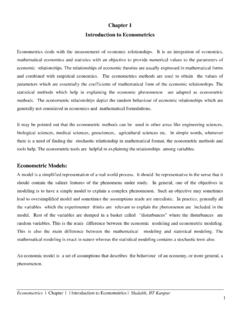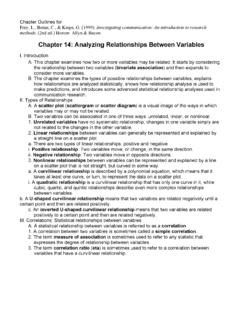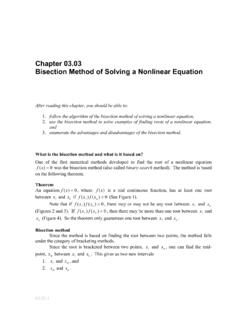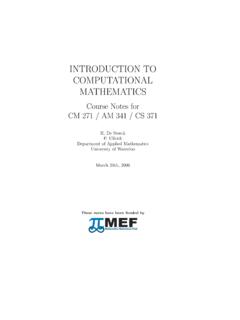Transcription of An Introduction to Mixed Methods Research
1 An Introduction to Mixed Methods Research by John W. Creswell, of Nebraska-LincolnSSP, University of Nebraska-LincolnMarch 9, 2007 Please do not duplicate or use these slides without the express permission of the of Qualitative and Mixed Methods Research (OQMMR), Educational Psychology, UNL Purpose: To provide consultation on qualitative and Mixed Methods Research , help scholars develop proposals for funding, and help conduct and evaluate funded projects. 5 : Creswell, Plano Clark, Lu, Green, Shope; 2 RA s Began 5 years ago Current projects in health sciences, physics, language arts, family/child Research , educational assessment, veterans affairs Funding sources: NIH, NSF, Dept of Veterans Affairs, National Department of Education, Kellogg Foundation, Esperance Family Foundation, NE Dept of Education 23 funded projects since opening; 28 journal publications and 5 books or book chapters Editorial Office of the Journal of Mixed Methods Research Self-supporting Research office3 Topics that I address in my Mixed Methods classes and workshops: Core idea of Mixed Methods Research Assumptions about Research needed When to use Mixed Methods Research Basic components Mixed Methods literature Philosophical assumptions Mixed Methods designs Criteria for choosing a design Procedural challenges in using designs Standards for evaluation Future Research 4 Understanding the core idea of Mixed Methods Research Quantitative Data Qualitative DataMethodology(called MixedMethods Research )5 Learning the assumptions about Research needed to conduct this form of inquiry Qualitative is legitimate Knowledge of qualitative Research .
2 Methodology evolves Diversity in methodology Times when quantitative and qualitative inadequate6 Identifying situations in which Mixed Methods Research is needed You are measuring a concept on an instrument. You have a sense that scores are not telling you the entire story. If you just asked a few people about the concept you might obtain a better Methods Research provides a more complete understanding of the Research problem than either quantitative or qualitative situations in which Mixed Methods Research is needed You look over the instruments available to study a concept. They were developed from a different sample/population than the one you are studying. You consider that you will need to develop an instrument before you can administer it to your Mixed Methods is a methodology for developing better, more context specific instruments. You have gathered data about a factors that predict a concept on several instruments.
3 Although you have general information about the importance of predictors, you can only guess as to what explains why the results Methods helps to explain results (or how mechanisms work) in causal models. 8 Identifying situations in which Mixed Methods Research is needed You are conducting an intervention study. You have an intervention that was developed by other researchers. You are not certain that it will work with the sample you are Methods is a way to explore first to determine if an intervention will work. We want to evaluate the performance of an organization. This calls for understanding the expected outcomes of the organization (needs assessment), designing some instruments to measure those outcomes, and then helping to explain why the outcomes Methods is an approach to tie together several steps in an evaluation process. 9 Learning the basic components involved in Mixed Methods Research Mixed Methods Research is a methodology for conducting Research that involves collecting, analyzing, and integrating quantitative and qualitative Research in a single study or a longitudinal program of inquiry.
4 The purpose of this form of Research is that both qualitative and quantitative Research , in combination, provide a better understanding of a Research problem or issue than either Research approach alone. 10It is a Research methodology The entire process of Research Philosophical assumptions of inquiry Research questions Data collection Data analysis Data interpretation Data reporting11It involves quantitative Research A Research approach that involves: Variables, hypotheses, questions Instruments, closed-ended questions, reliability, validity Statistical analysis Generalizability, replicability, control, and lack of bias12It involves qualitative Research An inquiry approach which includes: Central phenomenon Broad, general questions Views of participants Reciprocity and respect Description and themes Interpretation Personal reflexivity Flexible structure Meaning or advocate for groups/individuals13It involves collecting both quantitative and qualitative data Quantitative data Instruments Checklists Records Qualitative data Interviews Observations Documents Audio-visual materials14It involves quantitative and qualitative data analysis Qualitative analysis Use text and images, For coding For theme development For relating themes Quantitative analysis Use statistical analysis, For description For comparing groups For relating variables15It involves mixing the data ResultsConnect data:ResultsConverge data:Embed the data:Quan dataQual dataQualQuanQualQuan16It may consist of a single study or multiple studies Single Study:Multiple Studies.
5 Quan Qual Qual QuanStudy 1 QuanQualResultsStudy 2 Study 3 Study 417 Recognizing the body of Mixed Methods literature 1988, 1989 books, articles by sociologists, evaluators Accelerated interest in 1990s 14 books Journals Conference papers Methodological journal article publications Empirical journal article publications US and international interest1819 Designing and Conducting Editors: John W. Creswell and Abbas TashakkoriManaging Editor: Vicki ClarkEmail: addressed in this body of literature Paradigm use Research designs Threats to rigor of the designs Sampling procedures Data analysis approaches Writing study aims, Research questions Notation system Interdisciplinary team Research Writing Mixed Methods studies Evaluating Mixed Methods studies22 Examining the philosophical assumptions behind Mixed Methods researchWorldview or philosophy ( , attitudes and beliefs about knowledge, such as constructivism, post-positivism) Theoretical lens ( , feminist, racial)Methodological approach ( , experiemental, survey, ethnography, Mixed Methods ) Methods of data collection ( interviews, focus groups)Adapted from Crotty M.
6 The foundations of social Research : Meaning and perspective in the Research process. London: Sage, about aspects of a worldview or paradigm How we see reality in this world (ontology) How we know what we know (epistemology) How we view the role of values (axiology) How we conduct the procedures of Research (methodology) How we view the use of language in Research (rhetorical)24 Postpositivism Determination Reductionism Empirical observation and measurement Theory verificationConstructivism Understanding Multiple participant meanings Social and historical construction Theory generationAdvocacy/Participatory Political Empowerment issue-oriented Collaborative Change-orientedPragmatism Consequences of actions Problem-centered Pluralistic Real-world practice orientedUnderstanding four typical worldviews25 Understanding the different worldview stances in Mixed Methods Research : Different stances: Single worldview pragmatism, transformative-emancipatory (advocacy/participatory) Multiple worldviews made explicit Worldviews change depending on type of design26 Learning about the types of Mixed Methods designs typically used in researchI.
7 Triangulation Mixed Methods DesignII. Embedded Mixed Methods DesignQUANData and ResultsQUANPre-testData and Results+QUALData and ResultsQUANPost-testData and ResultsInterpretationQual Process27 III. Explanatory Mixed Methods DesignIV. Exploratory Mixed Methods DesignQUANData and ResultsQUALData and ResultsqualData and ResultsquanData and Results Follow-upBuilding28 Learning about the concurrent Triangulation Design One-phase project Concurrent data collection Combine results Intent is to merge two separate strands of dataConcurrent Triangulation Design Visual Model Procedure Product Procedure Product Nurreric Semi- Text data stn rt1 JrFri QUAN rl t c;tn rt1 JrFri QUAL I m (JP. rl;it" c:bservation data collection interviews data collection c:ha:klist Cbservations Chart audits Docum01ts Artifacts l Statistical QUAN Test Ceding QUAL Cedes analysis data analysis statistic Tt"ematic Tt"erres SEM analysis data analysis GROUNDED ~ THEORY RESULTS Co11paring results Composite Model 30 Learning about the Embedded Design Supportive role of one type of data or both forms of data ( Mixed Methods within an experiment, case study, narrative study, correlational design) Concurrent or sequential data collection One phase or two phases Intent of enhancing the design 31 Process collectionand analysis of qualitativedata(before, during, after trial)Embedded Research Design ExperimentInterventionQuanData collectionPre-testQuanData collectionPost-test32 Procedures: Three groups.)
8 Control group, compliance Intervention group, alliance intervention group group comparisons Outcome measures: 1) attitudes toward medication 2) adherence to treatment 3) avoidance of relapse DAI measure completed 3 times (pre, post, & follow up) Products: numerical item scores Change scores Test statistics Experimental MethodologyQUANQUANPre-InterventionPost- & Follow-up Follow-upMeasureMeasures Procedures: Discuss treatment effectiveness Discuss themes in context of interventions and outcomesProducts: DiscussionProcedures: One-on-one semi- structured interviews exiting the trial, participants from two experimental conditions; Thematic analysisProducts: Transcripts Themes and quotes Procedures: One-on- one semi-structured interviews Thematic analysis Products: Transcripts Developed intervention treatmentqual before interventionqual after interventionOverall results and interpretation Flow of the experiment Embedded Design within an Experiment 33 Learning about the Explanatory Sequential Design?
9 Sequential data collection Two-phase project Quantitative phase first; qualitative, second One phase builds on other phase Intent: to explain results or to select participants to better understand results An Explanatory Sequential Design Quantitative Data* Number of cigarettes CES-D6 Qualitative Data* Semi-structured interviews, audio recorded and transcribed * Data collected 10 times over the course of a calendar year for 40 participants Quantitative Analysis Graphic plot of CES-D6 scores over time for each participant Graphic plot of cigarettes/day values over time for each participant Case Selection Qualitative Analysis Description of each case Identification of life events occurring during critical months where smoking increased or decreased Thematic analysis of life events for each case Cross-case thematic analysis Interpretation Why did changes in smoking occur?
10 Quantitative Data Collection(quan) Qualitative Data Collection Interpretation based on quanand QUAL results Qualitative Data Analysis(QUAL) Case Selection Quantitative Data Analysis(quan) Selected 5 casesmaximally varyingIdentified criticalmonths in which smoking variedSource: Creswell, Plano Clark, Shope, McVea. (in progress)+35 Learning about the Exploratory Sequential Design Sequential data collection Two-phase project Qualitative phase first; quantitative, second One phase builds on other phase Intent: to first explore in order to develop an instrument, to identify categories, taxonomy for follow upPhase I Qualitative Research - Year 1 Qualitative Data CollectionUnstructured Interviews -50 participants 8 observations at the site16 documentsQualitative Data AnalysisText Analysis: Using QSR N6 Qualitative FindingsDevelopment of codes and themesfor each sitePhase II Quantitative Research - Year 2 Quantitative Instrument DevelopmentQuantitative Test of the InstrumentCreate approximately a 80-iteminstrument plus demographicsAdminister survey to 500 individualsDetermine factor structure of items and conduct reliability analysis for scalesQuantitative ResultsDetermine how groups differusing ANOVA test Exploratory Sequential Design37 Identifying criteria for choosing a design Intent for conducting Mixed Methods Research Concurrent (each strand stands alone then brought together) or sequential (one strand builds on the other)
